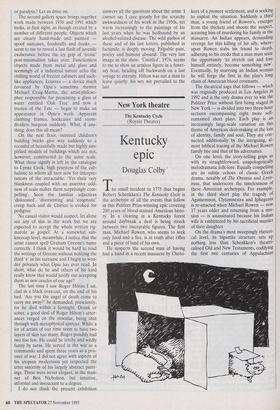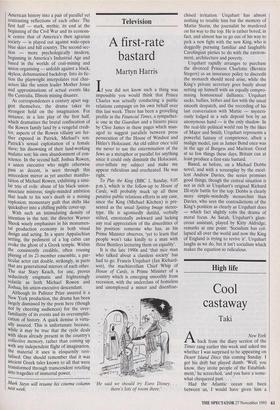New York theatre
The Kentucky Cycle (Royale Theater)
Kentucky epic
Douglas Colby '
The small incident in 1775 that begins Robert Schenkken's The Kentucky Cycle is the archetype of all the events that follow in this Pulitzer Prize-winning epic covering 200 years of blood-stained American histo- ry. In a clearing in a Kentucky forest around daybreak a deal is being struck between two inscrutable figures. The first man, Michael Rowen, who seems to seek only food and a fire, is in truth after rifles and a piece of land of his own.
He suspects the second man of having had a hand in a recent massacre by Chero- kees of a pioneer settlement, and is seeking to exploit the situation. Suddenly a third man, a young friend of Rowen's, emerges from the thickets and shoots the suspect, accusing him of murdering his family in the massacre. An Indian appears, demanding revenge for this killing of his ally, where- upon Rowen stabs his friend to death, adhering to his credo that a man must seize the opportunity 'to stretch out and lose himself entirely, become something new'. Eventually, by marrying an Indian woman he will forge the first in the play's long chain of American blood covenants.
The theatrical saga that follows — which was originally produced in Los Angeles in 1992 and is the only drama ever to win the Pulitzer Prize without first being staged in New York — is divided into two three-hour sections encompassing eight more self- contained short plays. Each play is an increasingly large-scale variation on this theme of American deal-making at the loss of identity, family and soul. They are con- nected additionally by the intriguing, al- most biblical tracing of the Michael Rowen family line and that of his adversaries. On one level, the story-telling grips us with its straightforward, unapologetically melodramatic folk-lore. Equally compelling are its subtle echoes of classic Greek drama, notably of The Oresteia and Lysis- trata, that underscore the timelessness of these American archetypes. For example, in the third short play the tragedy of Agamemnon, Clytemnestra and Iphegenia is re-enacted when Michael Rowen — now 17 years older and returning from a mis- sion — is assassinated because his Indian wife is embittered by his sacrificial murder of their daughter.
On the drama's most sweepingly rhetori- cal level, its bipartite structure sets up nothing less than Schenkken's theatri- calised Old and New Testaments, codifying the first two centuries of Appalachian American history into a pair of parallel yet contrasting reflections of each other. The first half — stark, mythic, its end at the beginning of the Civil War and its econom- ic centre that of America's then agrarian society — is played out against wide-open blue skies and hill country. The second sec- tion — more psychologically modern, beginning in America's Industrial Age and based in the worlds of coal-mining and union organising — unfolds against a black, skyless, dehumanised backdrop. Into its fic- tion the playwright interpolates real char- acters like the union leader Mother Jones and approximations of actual events like the Centralia, Illinois mining disaster.
As correspondences a century apart sug- gest themselves, the drama takes its strongest hold on the imagination. For instance, in a late play of the first half, which dramatises the brutal confiscation of the Rowen family land by a vengeful credi- tor, aspects of the Rowen villainy are fur- ther exposed in Patrick, Michael's son: Patrick's sexual exploitation of a female slave; his disowning of their land-working mulatto son; his own abandonment of con- science. In the second half, Joshua Rowen, a union executive who might otherwise pass as decent, is seen through this antecedent mirror as yet another manifes- tation of Michael Rowen, exhibiting a simi- lar trio of evils: abuse of his black union- associate mistress; single-minded ambition that leads to his son's death in a mining explosion; momentary guilt that shifts like quicksilver into a chilling public cover-up.
With such an intimidating density of intention in the text, the director Warner Shook wisely emphasises in his monumen- tal production economy in both visual design and acting. In a spare Appalachian setting, the pediment of a log cabin can evoke the ghost of a Greek temple. Within the consistently credible, often rousing playing of its 21-member ensemble, a par- ticular actor can double, strikingly, in parts that are generational mirrors of each other. The star Stacy Keach, for one, proves seductively enigmatic and frighteningly volatile as both Michael Rowen and Joshua, his union-executive descendant.
Although its Pulitzer Prize assured it a New York production, the drama has been largely dismissed by the press here (though not by cheering audiences) for the over- familiarity of its events and its oversimplifi- cation of history. A quick demise is virtu- ally assured. This is unfortunate because, while it may be true that the cycle deals with ideas already present in the country's collective memory, rather than coming up with any independent flight of imagination, the material it uses is eloquently revi- talised. One should remember that it was ancient Greek tales known to all that were transformed through transcendent retelling into tragedies of immortal power.











































































 Previous page
Previous page